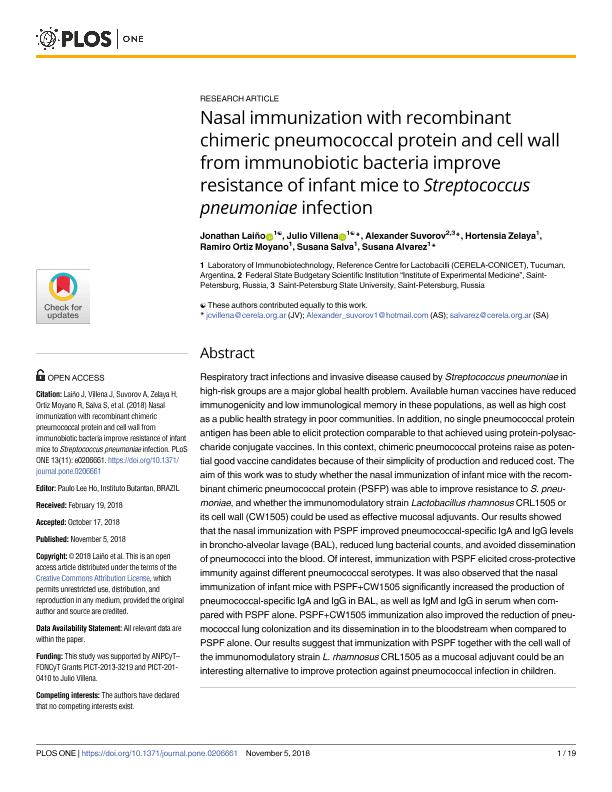Mostrar el registro sencillo del ítem
dc.contributor.author
Laiño, Jonathan Emiliano

dc.contributor.author
Villena, Julio Cesar

dc.contributor.author
Suvorov, A.
dc.contributor.author
Zelaya, María Hortensia del Rosario

dc.contributor.author
Ortiz Moyano, Francisco Ramiro

dc.contributor.author
Salva, Maria Susana

dc.contributor.author
Alvarez, Gladis Susana

dc.date.available
2019-08-26T18:51:47Z
dc.date.issued
2018-11
dc.identifier.citation
Laiño, Jonathan Emiliano; Villena, Julio Cesar; Suvorov, A.; Zelaya, María Hortensia del Rosario; Ortiz Moyano, Francisco Ramiro; et al.; Nasal immunization with recombinant chimeric pneumococcal protein and cell wall from immunobiotic bacteria improve resistance of infant mice to Streptococcus pneumoniae infection.; Public Library of Science; Plos One; 13; 11; 11-2018; 1-19
dc.identifier.issn
1932-6203
dc.identifier.uri
http://hdl.handle.net/11336/82128
dc.description.abstract
Respiratory tract infections and invasive disease caused by Streptococcus pneumoniae in high-risk groups are a major global health problem. Available human vaccines have reduced immunogenicity and low immunological memory in these populations, as well as high cost as a public health strategy in poor communities. In addition, no single pneumococcal protein antigen has been able to elicit protection comparable to that achieved using protein-polysaccharideconjugate vaccines. In this context, chimeric pneumococcal proteins raise as potential good vaccine candidates because of their simplicity of production and reduced cost. The aim of this work was to study whether the nasal immunization of infant mice with the recombinant chimeric pneumococcal protein (PSFP) was able to improve resistance to S. pneumoniae, and whether the immunomodulatory strain Lactobacillus rhamnosus CRL1505 or its cell wall (CW1505) could be used as effective mucosal adjuvants. Our results showed that the nasal immunization with PSPF improved pneumococcal-specific IgA and IgG levels in broncho-alveolar lavage (BAL), reduced lung bacterial counts, and avoided dissemination of pneumococci into the blood. Of interest, immunization with PSPF elicited cross-protective immunity against different pneumococcal serotypes. It was also observed that the nasal immunization of infant mice with PSPF+CW1505 significantly increased the production of pneumococcal-specific IgA and IgG in BAL, as well as IgM and IgG in serum when compared with PSPF alone. PSPF+CW1505 immunization also improved the reduction of pneumococcal lung colonization and its dissemination in to the bloodstream when compared to PSPF alone. Our results suggest that immunization with PSPF together with the cell wall of the immunomodulatory strain L. rhamnosus CRL1505 as a mucosal adjuvant could be an interesting alternative to improve protection against pneumococcal infection in children.
dc.format
application/pdf
dc.language.iso
eng
dc.publisher
Public Library of Science

dc.rights
info:eu-repo/semantics/openAccess
dc.rights.uri
https://creativecommons.org/licenses/by-nc-sa/2.5/ar/
dc.subject
Lactic Acid Bacteria
dc.subject
Chimeric Pneumococcal Protein
dc.subject
Cell Wall
dc.subject
Immunobiotic Bacteria
dc.subject.classification
Inmunología

dc.subject.classification
Medicina Básica

dc.subject.classification
CIENCIAS MÉDICAS Y DE LA SALUD

dc.subject.classification
Inmunología

dc.subject.classification
Medicina Básica

dc.subject.classification
CIENCIAS MÉDICAS Y DE LA SALUD

dc.title
Nasal immunization with recombinant chimeric pneumococcal protein and cell wall from immunobiotic bacteria improve resistance of infant mice to Streptococcus pneumoniae infection.
dc.type
info:eu-repo/semantics/article
dc.type
info:ar-repo/semantics/artículo
dc.type
info:eu-repo/semantics/publishedVersion
dc.date.updated
2019-08-20T14:16:00Z
dc.journal.volume
13
dc.journal.number
11
dc.journal.pagination
1-19
dc.journal.pais
Estados Unidos

dc.journal.ciudad
San Francisco
dc.description.fil
Fil: Laiño, Jonathan Emiliano. Consejo Nacional de Investigaciones Científicas y Técnicas. Centro Científico Tecnológico Conicet - Tucumán. Centro de Referencia para Lactobacilos; Argentina
dc.description.fil
Fil: Villena, Julio Cesar. Consejo Nacional de Investigaciones Científicas y Técnicas. Centro Científico Tecnológico Conicet - Tucumán. Centro de Referencia para Lactobacilos; Argentina
dc.description.fil
Fil: Suvorov, A.. Saint-petersburg State University, Rusia; Rusia
dc.description.fil
Fil: Zelaya, María Hortensia del Rosario. Consejo Nacional de Investigaciones Científicas y Técnicas. Centro Científico Tecnológico Conicet - Tucumán. Centro de Referencia para Lactobacilos; Argentina
dc.description.fil
Fil: Ortiz Moyano, Francisco Ramiro. Consejo Nacional de Investigaciones Científicas y Técnicas. Centro Científico Tecnológico Conicet - Tucumán. Centro de Referencia para Lactobacilos; Argentina
dc.description.fil
Fil: Salva, Maria Susana. Consejo Nacional de Investigaciones Científicas y Técnicas. Centro Científico Tecnológico Conicet - Tucumán. Centro de Referencia para Lactobacilos; Argentina
dc.description.fil
Fil: Alvarez, Gladis Susana. Consejo Nacional de Investigaciones Científicas y Técnicas. Centro Científico Tecnológico Conicet - Tucumán. Centro de Referencia para Lactobacilos; Argentina
dc.journal.title
Plos One

dc.relation.alternativeid
info:eu-repo/semantics/altIdentifier/url/https://journals.plos.org/plosone/article?id=10.1371/journal.pone.0206661
dc.relation.alternativeid
info:eu-repo/semantics/altIdentifier/url/https://doi.org/10.1371/journal.pone.0206661
Archivos asociados
